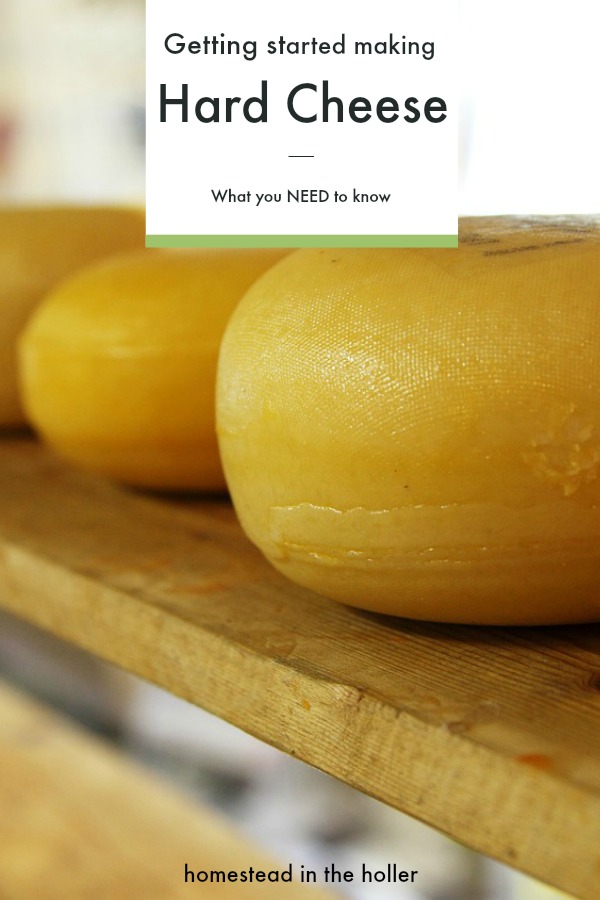 Homestead in the Holler is a participant in the Amazon Services LLC Associates Program, an affiliate advertising program designed to provide a means for sites to earn advertising fees by advertising and linking to amazon.com.
Homestead in the Holler is a participant in the Amazon Services LLC Associates Program, an affiliate advertising program designed to provide a means for sites to earn advertising fees by advertising and linking to amazon.com.
One of the biggest benefits of having your own dairy animal, be it goat or cow, is plenty of fresh, raw milk. An abundance of fresh milk means making dairy products yourself. Yogurt, kefir, butter and cheese. Several friends have told me that making hard cheeses sounds difficult and are intimidated by the process. Not so!
Cheesemaking is really not difficult and quite fun! Once you get started, you will soon want to make all the cheese and may be talking your husband into making your very own cheese cave. Ahem.
Here is what you need to get started making hard cheese.
Milk
A source of milk is needed before you get started. What your source is doesn’t matter, milking your own animal or purchasing milk from a farmer or the store, it will all work. Most recipes call for 2 gallons of milk for a wheel of hard cheese.
Equipment
When getting ready to make hard cheese, you will need some equipment to get started. Some things are absolutely necessary and some things you can replace with things that you already have in your kitchen.
Cheese Press with pressure gauge
The most important piece of equipment for making hard cheese is a good cheese press. I tried a “beginner’s cheese press” when I first started and it resulted in a lot of frustration and cheese that did not turn out. A cheese press with a pressure gauge is crucial. Instead of stacking bricks, weights or any other heavy items onto your cheese, you can just turn the pressure to the amount required in the recipe. 30 pounds of pressure? No problem! Avoiding leaning towers of bricks in the kitchen is always a good thing.
A cheese press is the most expensive part of getting started, but the rest of the items required are either already in your kitchen or inexpensive.
Thermometer
A thermometer is another crucial tool in cheese making. Making cheese is all about raising the temperature of the milk in a precise way, having a thermometer will result in good cheese.
Stock Pot
Large stock pot, large enough to hold 1-3 gallons of milk is necessary. I use a 3 gallon stainless steel stock pot which works great. This is the same stock pot that I use for making chicken broth or tomato sauce. Multi-functioning at it’s best!
Slotted Spoon
Slotted spoons work the best to stir in the cheese cultures and rennet. A large spoon will also work just as well. As long as you have a long handled spoon, you are all set!
Large knife
There are curd cutters out there that you can purchase. They aren’t necessary, especially when you’re just getting started. Any large knife that will reach the bottom of your stock pot will do.
Colander
A colander is used for draining the curds and whey. Any type of colander will work great because you will line it with cheesecloth before pouring your curds and whey.
Cheesecloth
Cheesecloth is needed to line your cheese press when you make hard cheese.
Cheese Cultures & Rennet
Cheese cultures and rennet are necessary when making cheese. These cultures inoculate the milk with good bacteria which multiply by consuming the lactose (milk sugar) in the milk. The result raises the acidity and helps prevent bad bacteria from taking over.
Rennet is an enzyme, Chymosin, that is used to thicken the milk in the cheesemaking process. There are several sources for rennet, but most common are animal rennet and plant based rennet.
Cheese Wax
Cheese wax is used once your cheese is out of the cheese press and the outside edges have dried. The wax keeps the cheese from drying out too much and helps to slow down the growth of mold.
No Cheese Cave Necessary
A cheese cave is really not necessary to age your cheese in, especially when first starting out. You want to store your waxed cheese in a slightly damp environment, between 35 and 55 degrees Fahrenheit. Most basements or root cellars meet those requirements. If that doesn’t work for you, you can age your cheese in the refrigerator.
Time
Make hard cheese on a day that you have nothing else going on, especially the first few times that you make it. It takes about 4 hours from the time you start your cheese, to the time you put it in the cheese press. It is a start and stop process though, waiting for the milk to culture, waiting for the rennet to set and slowly heating the curds. Cheese does not like to be rushed. Don’t be intimidated though, all you need to do is a lot of gentle stirring and watching the thermometer.
Recipes
Use a reputable recipe book when cheesemaking. Tried and true recipes will help you have success right off. Here is a great book to get started with.
Patience
Making hard cheese is a great lesson in patience. It take time to slowly heat the curds up. Don’t rush through that part or your cheese won’t turn out how you expect. Once you take that beautiful wheel of hard cheese out of the cheese press, the next step is to age the cheese. Depending on the cheese that you have made, you may need to wait months before you can try your delectable cheese. Aging the cheese improves the flavor, but sometimes it is hard to wait!
If you don’t want to wait, make Queso Fresco. Queso Fresco is an excellent cheese to start with when you’re learning to make hard cheeses. You go through similar steps and use a cheese press, but there is no wait time after the cheese comes out of the press. No waxing, no waiting! It comes out of the cheese press and is ready to eat. Queso Fresco is very versatile, excellent in grilled cheese sandwiches and grated into soups. It will keep for 2 weeks in the fridge, if you can keep it that long.
What do you say? Are you ready to try your hand at making some hard cheese?

Hi! Around here I wear many hats. Homesteader, farmer, homemaker, homeschool mom, gardener and builder. We strive for a simple, self-sufficient life on our little piece of paradise. Read more




Pingback: Stuffed Bacon Cheeseburger Recipe (Low Carb) · Hidden Springs Homestead
Pingback: How to Preserve Your Harvest Like a Pro! - The New Homesteader's Almanac
Pingback: How to Preserve the Harvest Like a Pro! - The Self Sufficient HomeAcre